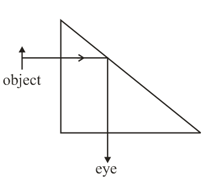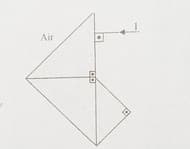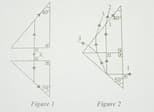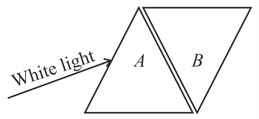Refraction of Light through a Prism
Refraction of Light through a Prism: Overview
A prism is a transparent material bounded by two triangular and three rectangular lateral surfaces. The rectangular surfaces are inclined to each other. The shape of a prism makes the refracted ray deviate from the direction of the incident ray.
Important Questions on Refraction of Light through a Prism
A ray coming from an object is reflected totally at the slant surface of the prism. The possible orientation of the image is

A ray of white light is incident on the face of a prism of refractive index . The ray emerges from the opposite face having undergone minimum deviation. If the angle of incidence is double the angle of refraction within the prism, then the angle of the prism is
The angle of minimum deviation for prism of angle is . The refractive index of the material of the prism is
Glass prisms with an isosceles right triangle section are placed in the air environment as shown in the figure, and an optical system is installed.

How many different full reflections does the optical system make until the single col beam sent leaves the system?
When separated two prisms in figure. 1 bends the rays from K as shown.

If two prisms are joined as shown in figure 2. What number represents the outgoing ray of incident ray I?
If the refractive index of the material of a prism is and its angle of minimum deviation is then the angle of the prism is
For the angle of minimum deviation of a prism to be equal to its refracting angle, the prism must be made of a material whose refractive index
Calculate refractive index of a equilateral glass prism for a light of red colour. Angle of minimum deviation for red colour is .
A ray of light incident at an angle of on a prism of refracting angle suffers minimum deviation. Determine the angle of minimum deviation in degrees.
The angle of _____ increases with the increase in the angle of prism.
The angle of deviation depends on the refractive index of the glass.
The angle of deviation of light ray in a prism depends on the angle of prism and angle of _____.
When a beam of white light passes through a prism it gets
For a given prism, the _____ light deviates most and the red light deviates least.
is equal to the ratio of real depth to the _____.
Consider two equivalent, triangular hollow prisms A and B made of thin glass plates and arranged with negligible spacing as shown in the figure. A beam of white light is incident on prism A from the left. Given that, the refractive index of water is inversely related to temperature, the beam to the right of prism B would not appear white, if

A ray of light passes through an equilateral prism such that angle of incidence is equal to angle of emergence and the latter is equal to of the angle of prism. The angle of deviation is (in)
How does an increasing angle of incidence affect the angle of deviation generated by a prism?
A glass prism has a right-triangular cross section, , with . A ray of light parallel to the hypotenuse, and, incident on the side, emerges grazing the side, . Another ray, again parallel to the hypotenuse, , incident on the side, suffers total internal reflection at the side, . Which one of the following must be true about the refractive index, of the material of the prism?
Monochromatic light passes through a prism. Compared to that in air, inside the prism the light's
